Arrange in ascending and descending order, Put appropriate sign between the fractions, Chapter 7 – Fractions – Exercise – 7.4 Solutions for class 6 CBSE, Stepwise Solutions for NCERT Class 6 Mathematics Chapter 7 – Fractions – Exercise – 7.4, Class 6th Maths solutions Wikipedia, Questions and Answers for NCERT Mathematics Class 6, Questions and Solutions for NCERT Mathematics Class Sixth Exercise 7.4 of Chapter 7, CBSE Class sixth Maths Questions and Solutions, Questions and Solutions for NCERT Class 6th Mathematics Chapter 7 – Fractions – Exercise – 7.4, Detailed Solutions for NCERT Class 6th Mathematics Chapter 7 – Fractions – Exercise – 7.4, Questions and Solutions for NCERT Class 6 Mathematics Chapter 7 – Fractions – Exercise – 7.4, Stepwise Solutions for NCERT Class 6 Mathematics Exercise 7.4, Solutions for NCERT Class 6 Mathematics Chapter 7, Stepwise and detailed solutions for NCERT Class 7 – Fractions – Exercise – 7.4, Detailed Solutions for Solutions for NCERT Class 6 Mathematics, NCERT Class 6th Mathematics Chapter Chapter 7 – Fractions – Exercise – 7.4, Chapter 7 – Fractions – Exercise – 7.4 NCERT Solutions.
Questions and Solutions for NCERT Class 6th Mathematics Chapter 7 – Fractions – Exercise 7.4
1. Write shaded portion as fraction. Arrange them in ascending and descending order using correct sign ‘<’, ‘=’, ‘>’ between the fractions:
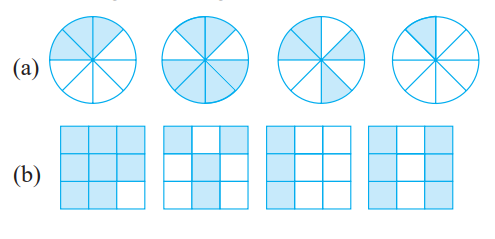
Solution:
(a) 3/8, 6/8, 4/8, 1/8
Ascending Order : 1/8 < 3/8 < 4/8 < 6/8
Descending Order : 6/8 > 4/8 > 3/8 > 1/8
(b) 7/9, 4/9, 3/9, 6/9
Ascending Order : 3/9 < 4/9 < 6/9 < 8/9
Descending Order : 8/9 > 6/9 > 4/9 > 3/9
(c) Show 2/6, 4/6, 8/6 and 6/6 on the number line. Put appropriate signs between the fractions given.
Answer:

5/6 > 2/6
3/6 > 0
1/6 < 6/6
8/6 > 5/6
2. Compare the fractions and put an appropriate sign.
Answer:
(a) 3/6 < 5/6
(b) 1/7 < 1/4
(c) 4/5 < 5/5
(d) 3/5 > 3/7
3. Make five more such pairs and put appropriate signs.
Sol: (a) 5/7 > 2/7
(b) 9/10 < 10/10
(c) 4/15 > 2/15
(d) 7/11 < 8/11
(e) 2/3 < 1/3
4. Look at the figures and write ‘<’ or ‘>’, ‘=’ between the given pairs of fractions.
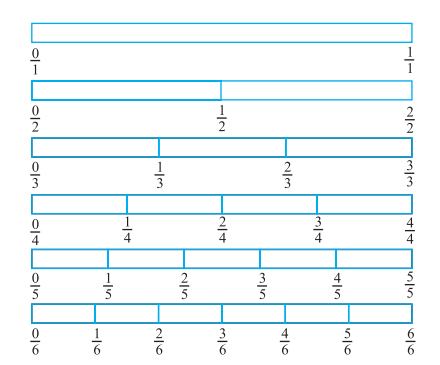
Solution:
(a) 1/6 < 1/3
(b) 3/4 > 2/6
(c) 2/3 > 2/4
(d) 6/6 = 3/3
(e) 5/6 < 5/5
5. How quickly can you do this? Fill appropriate sign. ( ‘<’, ‘=’, ‘>’)
Solution:
(a) 1/2 > 1/5
(b) 2/4 = 3/6
(c) 3/5 < 2/3
(d) 3/4 > 2/8
(e) 3/5 < 6/5
(f) 7/9 > 3/9
(g) 1/4 = 2/8
(h) 6/10 < 4/5
(i) 3/4 < 7/8
(j) 6/10 < 4/5
(k) 5/7 = 15/21
6. The following fractions represent just three different numbers. Separate them into three groups of equivalent fractions, by changing each one to its simplest form.
(a) 2/12 (b) 3/15 (c) 8/50 (d) 16/100 (e) 10/60 (f ) 15/75 (g) 12/60 (h) 16/96 (i) 12/75 (j) 12/72 (k) 3/18 (l) 4/25
Solution:

7. Find answers to the following. Write and indicate how you solved them.
(a) Is 5/9 equal to 4/5 ?
(b) Is 9/16 equal to 5/9 ?
(c) Is 4/5 equal to 16/20 ?
(d) Is 1/15 equal to 4/30 ?
Solution:
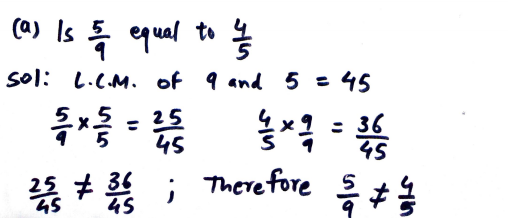
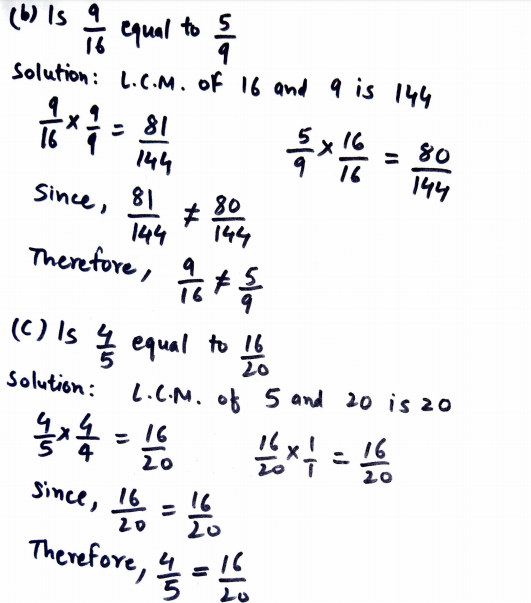
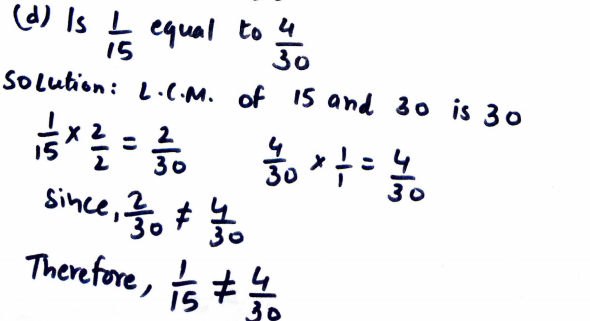
8. Ila read 25 pages of a book containing 100 pages. Lalita read 2/5 of the same book. Who read less?
Solution: Total number of pages in the book = 100
Pages read by Ila = 25
Fraction of pages read by Ila = 25/100 = 1/4
Fraction of pages read by Lalita = 2/5
Since 1/4 < 2/5
Therefore, Ila read less.
9. Rafiq exercised for 3/6 of an hour, while Rohit exercised for 3/4 of an hour. Who exercised for a longer time?
Solution : Rafiq exercised for 3/6 of an hour
Rohit exercised for 3/4 of an hour
Since 3/4 > 3/6
Therefore, Rohit exercised for longer time.
10. In a class A of 25 students, 20 passed in first class; in another class B of 30 students, 24 passed in first class. In which class was a greater fraction of students getting first class?
Solution: In class A, fraction of students passed in first class = 20/25 = 4/5
In class B, fraction of students passed in first class = 24/30 = 4/5
Hence, both class A and B has same fraction of students getting first class.
You can find the solutions for Class 6 Mathematics previous exercises from here
- Chapter 7 – Fractions – Exercise – 7.3
- Fractions – Exercise – 7.2
- Chapter 7 – Fractions – Exercise – 7.1
- Integers – Exercise – 6.3
- Chapter 6 – Integers – Exercise 6.2
- Integers – Exercise 6.1
- Understanding Elementary Shapes – Exercise 5.9
- Chapter 5 – Understanding Elementary Shapes – Exercise 5.8
- Understanding Elementary Shapes – Exercise 5.7
- Chapter 5 – Understanding Elementary Shapes – Exercise 5.6
- Understanding Elementary Shapes – Exercise 5.5
- Chapter 5 – Understanding Elementary Shapes – Exercise 5.4
- Understanding Elementary Shapes – Exercise 5.3
- Chapter 5 – Understanding Elementary Shapes – Exercise 5.2
- Understanding Elementary Shapes – Exercise 5.1
- Chapter Basic Geometrical Ideas – Exercise 4.6 Solutions
- Basic Geometrical Ideas – Exercise 4.5 Solutions
- Chapter 4 Basic Geometrical Ideas – Exercise 4.4 Solutions
- Basic Geometrical Ideas – Exercise 4.3 Solutions
- Chapter 4 Basic Geometrical Ideas – Exercise 4.2 Solutions
- Basic Geometrical Ideas – Exercise 4.1 Solutions
- Playing with Numbers – Exercise 3.7 Solutions
- Chapter 3 Playing with Numbers – Exercise 3.6 Solutions
- Playing with Numbers – Exercise 3.5 Solutions
- Chapter 3 Playing with Numbers – Exercise 3.4 Solutions
- Playing with Numbers – Exercise 3.3 Solutions
- Chapter 3 Playing with Numbers – Exercise 3.2 Solutions
- Playing with Numbers – Exercise 3.1 Solutions
- Whole Numbers – Exercise 2.3 Solutions
- Chapter 2 Whole Numbers – Exercise 2.2 Solutions
- Whole Numbers – Exercise 2.1 Solutions
- Knowing Our Numbers Solutions Exercise 1.3 Solutions
- Chapter 1 Knowing Our Numbers Solutions Exercise 1.2 Solutions
- Knowing Our Numbers Solutions Exercise 1.1 Solutions
